2013 VOLVO V60 remote start
[x] Cancel search: remote startPage 117 of 422

03 Your driving environment
Starting the engine
03
115
Operation
Remote control buttons for remote start.
Locking
Approach lighting
Information3
Remote starting the engineMaximum distance for enabling remote star-
ting of the engine is approx. 30 metres in unob-
structed space - in addition, the car must be
locked.
To remote start the engine:1. Briefly press on the remote control key's
lock button (1).
2. Follow this immediately afterwards with a
long press - at least 2 seconds - on
button (2).
If the conditions for ERS are fulfilled then the
following takes place:
1. All direction indicators flash quickly several
times.
2. The engine starts.
3. All direction indicators illuminate with a
constant glow for 3 seconds to verify that
the engine has started.
NOTE
After remote starting, the car continues to
be locked but with the alarm deactivated.
With PCC4 keyThe light indication for Approach
lighting5 flashes several times when
the button is pressed and then goes
to constant glow if all criteria for ERS
have been fulfilled. However, this does not
mean that ERS has started the engine.
To check whether ERS has started the engine,
the user can press the Information button (3) -
if the engine has started, there is a light indi-
cation on the button for Approach lighting (2).
Active functionsThe following functions are activated with a
remote started engine:
•Ventilation system
•Audio/video system.
Deactivated functionsThe following functions are deactivated with a
remote started engine:
•headlamps
•Position lamps
•Number plate lighting
•Windscreen wiper.
the engine is switched offThe following steps switch off an ERS-started
engine:
•The remote control key's lock button (1) is
depressed
•The car is unlocked
•A door is opened
3Only on PCC key, see page 47.4Read about the PCC key on page 47.5Read about Approach lighting on page 46 and 94.
ProCarManuals.com
Page 118 of 422
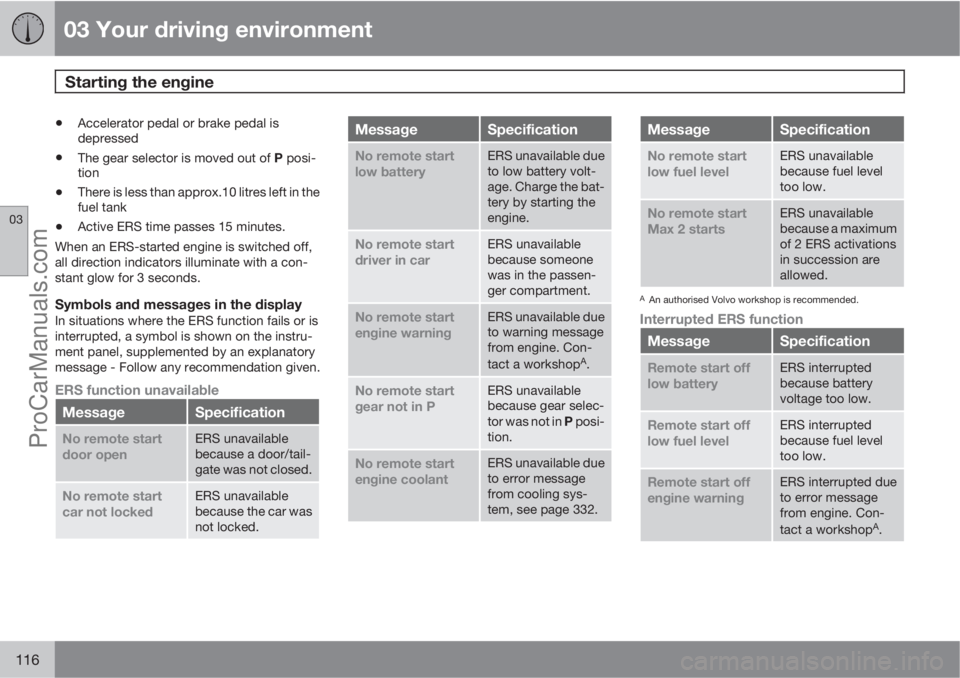
03 Your driving environment
Starting the engine
03
116
•Accelerator pedal or brake pedal is
depressed
•The gear selector is moved out of P posi-
tion
•There is less than approx.10 litres left in the
fuel tank
•Active ERS time passes 15 minutes.
When an ERS-started engine is switched off,
all direction indicators illuminate with a con-
stant glow for 3 seconds.
Symbols and messages in the displayIn situations where the ERS function fails or is
interrupted, a symbol is shown on the instru-
ment panel, supplemented by an explanatory
message - Follow any recommendation given.
ERS function unavailable
MessageSpecification
No remote start
door openERS unavailable
because a door/tail-
gate was not closed.
No remote start
car not lockedERS unavailable
because the car was
not locked.
MessageSpecification
No remote start
low batteryERS unavailable due
to low battery volt-
age. Charge the bat-
tery by starting the
engine.
No remote start
driver in carERS unavailable
because someone
was in the passen-
ger compartment.
No remote start
engine warningERS unavailable due
to warning message
from engine. Con-
tact a workshop
A.
No remote start
gear not in PERS unavailable
because gear selec-
tor was not in P posi-
tion.
No remote start
engine coolantERS unavailable due
to error message
from cooling sys-
tem, see page 332.
MessageSpecification
No remote start
low fuel levelERS unavailable
because fuel level
too low.
No remote start
Max 2 startsERS unavailable
because a maximum
of 2 ERS activations
in succession are
allowed.
AAn authorised Volvo workshop is recommended.
Interrupted ERS function
MessageSpecification
Remote start off
low batteryERS interrupted
because battery
voltage too low.
Remote start off
low fuel levelERS interrupted
because fuel level
too low.
Remote start off
engine warningERS interrupted due
to error message
from engine. Con-
tact a workshop
A.
ProCarManuals.com
Page 119 of 422
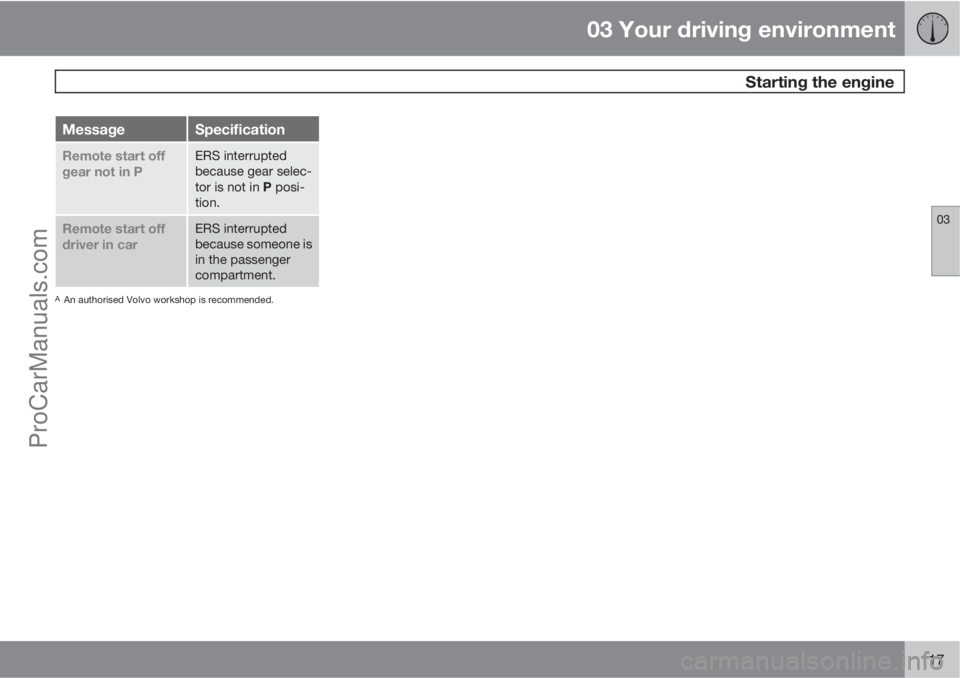
03 Your driving environment
Starting the engine
03
117
MessageSpecification
Remote start off
gear not in PERS interrupted
because gear selec-
tor is not in P posi-
tion.
Remote start off
driver in carERS interrupted
because someone is
in the passenger
compartment.
AAn authorised Volvo workshop is recommended.
ProCarManuals.com
Page 122 of 422

03 Your driving environment
Starting the engine – external battery
03
120
Jump starting
If the battery is flat then the car can be started
with current from another battery.
When jump starting the car, the following steps
are recommended to avoid short circuits or
other damage:
1. Insert the remote control key in key posi-
tion 0, see page 78.
2. Check that the donor battery has a voltage
of 12 V.
3. If the donor battery is installed in another
car - switch off the donor car's engine and
make sure that the two cars do not touch
each other.4. Connect one of the red jump lead's clamps
to the donor battery's positive terminal (1).
IMPORTANT
Connect the start cable carefully to avoid
short circuits with other components in the
engine compartment.
5. Open the clips on the front cover of the
battery in your car and remove the cover,
see page 345.
6. Connect the red jump lead's other clamp
onto the car's positive terminal (2).
7. Connect one of the black jump lead's
clamps to the donor battery's negative ter-
minal (3).
8. Connect the other clamp to a grounding
point, e.g. right-hand engine mounting at
the top, the outer screw head (4).
9. Check that the jump lead clamps are
affixed securely so that there are no sparks
during the starting procedure.
10. Start the engine of the "donor car" and
allow it to run a few minutes at a speed
slightly higher than idle approx. 1500 rpm.
11. Start the engine in the car with the dis-
charged battery.
IMPORTANT
Do not touch the crocodile clips during the
start procedure. There is a risk of sparks
forming.
12. Remove the jump leads in reverse order -
first the black and then the red.
> Make sure that none of the black jump
lead's clamps comes into contact with
the battery's positive terminal or the
clamp connected to the red jump lead!
WARNING
•The battery can generate oxyhydrogen
gas, which is highly explosive. A spark
can be formed if a jump lead is con-
nected incorrectly, and this can be
enough for the battery to explode.
•The battery contains sulphuric acid,
which can cause serious burns.
•If sulphuric acid comes into contact
with eyes, skin or clothing, flush with
large quantities of water. If acid
splashes into the eyes - seek medical
attention immediately.
For more information on the car's battery - see
page 344.
ProCarManuals.com
Page 140 of 422
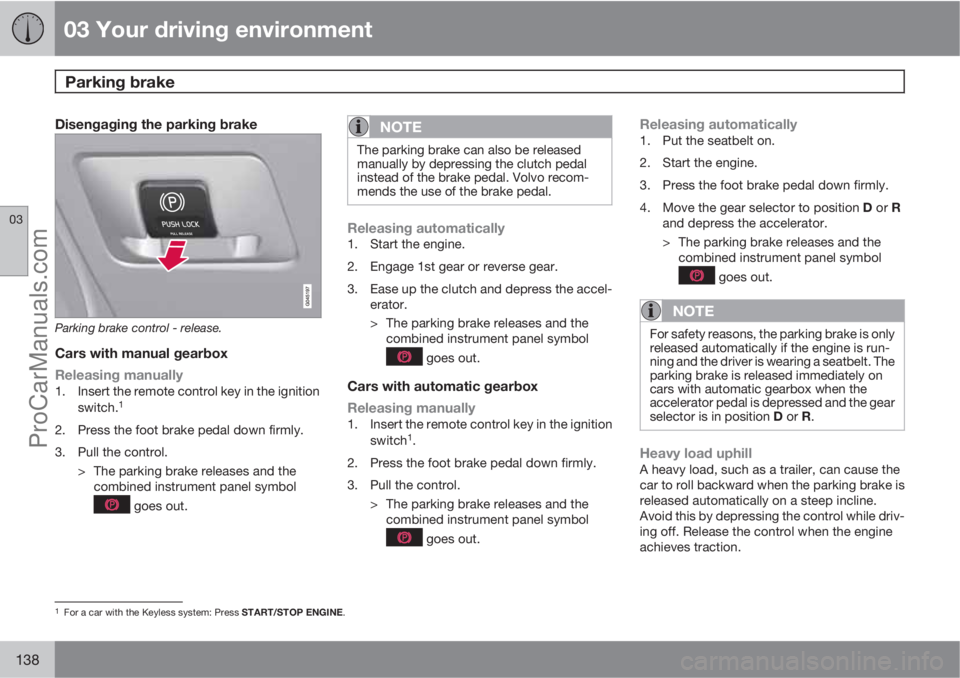
03 Your driving environment
Parking brake
03
138
Disengaging the parking brake
Parking brake control - release.
Cars with manual gearbox
Releasing manually
1. Insert the remote control key in the ignition
switch.1
2. Press the foot brake pedal down firmly.
3. Pull the control.
> The parking brake releases and the
combined instrument panel symbol
goes out.
NOTE
The parking brake can also be released
manually by depressing the clutch pedal
instead of the brake pedal. Volvo recom-
mends the use of the brake pedal.
Releasing automatically1. Start the engine.
2. Engage 1st gear or reverse gear.
3. Ease up the clutch and depress the accel-
erator.
> The parking brake releases and the
combined instrument panel symbol
goes out.
Cars with automatic gearbox
Releasing manually
1. Insert the remote control key in the ignition
switch1.
2. Press the foot brake pedal down firmly.
3. Pull the control.
> The parking brake releases and the
combined instrument panel symbol
goes out.
Releasing automatically1. Put the seatbelt on.
2. Start the engine.
3. Press the foot brake pedal down firmly.
4.
Move the gear selector to position D or R
and depress the accelerator.
> The parking brake releases and the
combined instrument panel symbol
goes out.
NOTE
For safety reasons, the parking brake is only
released automatically if the engine is run-
ning and the driver is wearing a seatbelt. The
parking brake is released immediately on
cars with automatic gearbox when the
accelerator pedal is depressed and the gear
selector is in position D or R.
Heavy load uphillA heavy load, such as a trailer, can cause the
car to roll backward when the parking brake is
released automatically on a steep incline.
Avoid this by depressing the control while driv-
ing off. Release the control when the engine
achieves traction.
1For a car with the Keyless system: Press START/STOP ENGINE.
ProCarManuals.com
Page 144 of 422

03 Your driving environment
HomeLink�Ÿ�Ÿ *
03
142* Option/accessory, for more information, see Introduction.
3.
Depress the HomeLink�Ÿ button being
programmed, hold it depressed for
5 seconds and then release it. Repeat if
necessary until the garage door is acti-
vated. If the door is not activated, press the
programmed HomeLink
�Ÿ button and hold
it depressed and check the indicator lamp.
>
Constant glow: The indicator lamp illu-
minates with a constant glow when the
button is kept depressed, this indicates
that the programming is complete.
The garage door, gate or similar should
now be activated when the pro-
grammed HomeLink
�Ÿ button is
depressed.
Glow not constant: The indicator lamp
flashes quickly for approx. 2 seconds
and then changes over to a constant
glow. In which case, continue with the
programming steps 4-6 in order to com-
plete the programming of a device with
rolling code (usually a garage door
opener).
4.
Locate the "programming button
2" on the
receiver for the garage door for example,
normally located close to the antenna's
bracket on the receiver.5. Depress and release the receiver's "pro-
gramming button". The button flashes for
approx. 30 seconds and the next step must
be carried out within this period.
6. While the receiver's "programming button"
is still flashing, press the button on
HomeLink
�Ÿ being programmed and hold it
depressed for approx. 2 seconds and then
release it. Repeat the press/hold/release
sequence up to 3 times to conclude the
programming.
Operation
When HomeLink�Ÿ is fully programmed it can be
used in place of the separate original remote
controls.
Press the programmed button and hold it
depressed until the garage door, alarm system,
etc. is activated (may take several seconds).
Naturally the original remote controls can still
be used in parallel with HomeLink
�Ÿ if required.
NOTE
If the ignition is switched off, HomeLink�Ÿ will
work for 30 minutes after the driver's door
has been opened.
If programming problems persist, contact
HomeLink�Ÿ on: www.homelink.com or ring
00 8000 466 354 65 (or premium rate phone
number +49 6838 907 277).
Resetting the HomeLink�Ÿ buttons
It is only possible to reset all of the
HomeLink�Ÿ buttons at the same time, not each
button individually. However, individual but-
tons can be reprogrammed, see the following
section "Programming individual buttons".
1. Depress the two outer buttons on
HomeLink
�Ÿ and do not release until the
indicator lamp starts to flash.
2. Release the buttons.
>
HomeLink
�Ÿ is now set in so-called
"learn mode" and is ready to be reprog-
rammed, see section "Programming
HomeLink®" on page 141.
2Button designation and colour vary depending on manufacturer.
ProCarManuals.com
Page 213 of 422
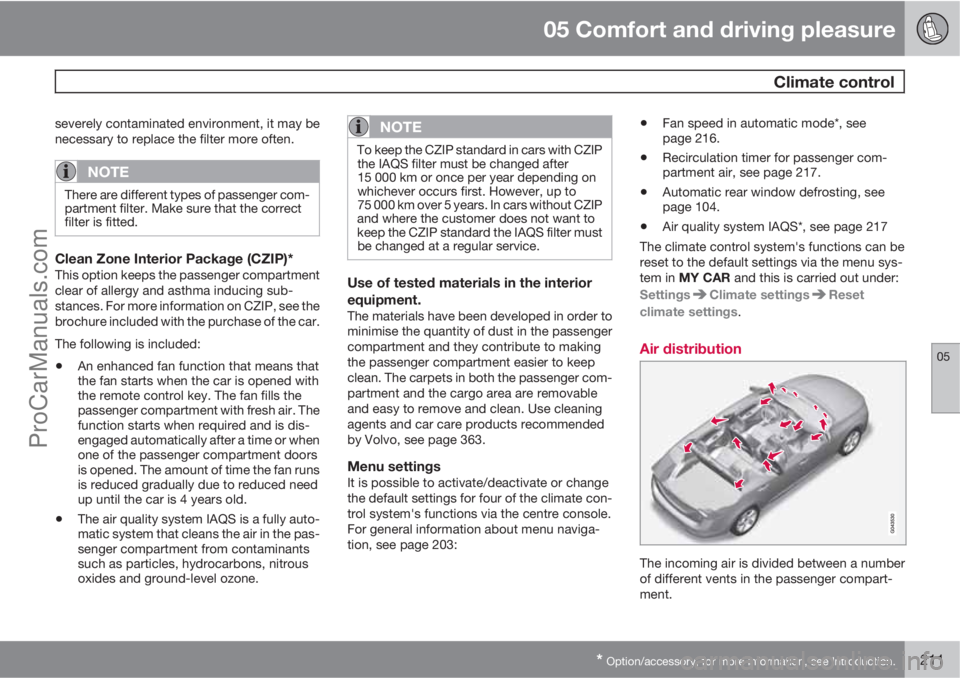
05 Comfort and driving pleasure
Climate control
05
* Option/accessory, for more information, see Introduction.211
severely contaminated environment, it may be
necessary to replace the filter more often.
NOTE
There are different types of passenger com-
partment filter. Make sure that the correct
filter is fitted.
Clean Zone Interior Package (CZIP)*This option keeps the passenger compartment
clear of allergy and asthma inducing sub-
stances. For more information on CZIP, see the
brochure included with the purchase of the car.
The following is included:
•An enhanced fan function that means that
the fan starts when the car is opened with
the remote control key. The fan fills the
passenger compartment with fresh air. The
function starts when required and is dis-
engaged automatically after a time or when
one of the passenger compartment doors
is opened. The amount of time the fan runs
is reduced gradually due to reduced need
up until the car is 4 years old.
•The air quality system IAQS is a fully auto-
matic system that cleans the air in the pas-
senger compartment from contaminants
such as particles, hydrocarbons, nitrous
oxides and ground-level ozone.
NOTE
To keep the CZIP standard in cars with CZIP
the IAQS filter must be changed after
15 000 km or once per year depending on
whichever occurs first. However, up to
75 000 km over 5 years. In cars without CZIP
and where the customer does not want to
keep the CZIP standard the IAQS filter must
be changed at a regular service.
Use of tested materials in the interior
equipment.
The materials have been developed in order to
minimise the quantity of dust in the passenger
compartment and they contribute to making
the passenger compartment easier to keep
clean. The carpets in both the passenger com-
partment and the cargo area are removable
and easy to remove and clean. Use cleaning
agents and car care products recommended
by Volvo, see page 363.
Menu settingsIt is possible to activate/deactivate or change
the default settings for four of the climate con-
trol system's functions via the centre console.
For general information about menu naviga-
tion, see page 203:
•Fan speed in automatic mode*, see
page 216.
•Recirculation timer for passenger com-
partment air, see page 217.
•Automatic rear window defrosting, see
page 104.
•Air quality system IAQS*, see page 217
The climate control system's functions can be
reset to the default settings via the menu sys-
tem in MY CAR and this is carried out under:
Settings
Climate settingsReset
climate settings.
Air distribution
The incoming air is divided between a number
of different vents in the passenger compart-
ment.
ProCarManuals.com
Page 223 of 422
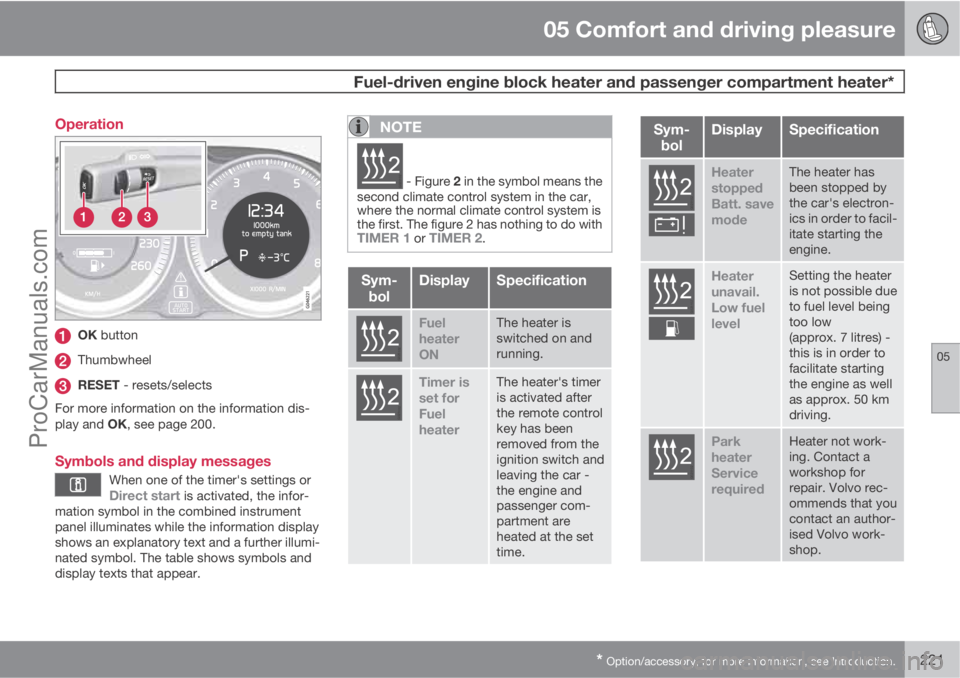
05 Comfort and driving pleasure
Fuel-driven engine block heater and passenger compartment heater*
05
* Option/accessory, for more information, see Introduction.221 Operation
OK button
Thumbwheel
RESET - resets/selects
For more information on the information dis-
play and OK, see page 200.
Symbols and display messages
When one of the timer's settings orDirect start is activated, the infor-
mation symbol in the combined instrument
panel illuminates while the information display
shows an explanatory text and a further illumi-
nated symbol. The table shows symbols and
display texts that appear.
NOTE
G02510
2 - Figure 2 in the symbol means the
second climate control system in the car,
where the normal climate control system is
the first. The figure 2 has nothing to do with
TIMER 1 or TIMER 2.
Sym-
bolDisplaySpecification
G02510
2
Fuel
heater
ONThe heater is
switched on and
running.
G02510
2
Timer is
set for
Fuel
heaterThe heater's timer
is activated after
the remote control
key has been
removed from the
ignition switch and
leaving the car -
the engine and
passenger com-
partment are
heated at the set
time.
Sym-
bolDisplaySpecification
G025102
Heater
stopped
Batt. save
modeThe heater has
been stopped by
the car's electron-
ics in order to facil-
itate starting the
engine.
G025102
Heater
unavail.
Low fuel
levelSetting the heater
is not possible due
to fuel level being
too low
(approx. 7 litres) -
this is in order to
facilitate starting
the engine as well
as approx. 50 km
driving.
G025102
Park
heater
Service
requiredHeater not work-
ing. Contact a
workshop for
repair. Volvo rec-
ommends that you
contact an author-
ised Volvo work-
shop.
ProCarManuals.com